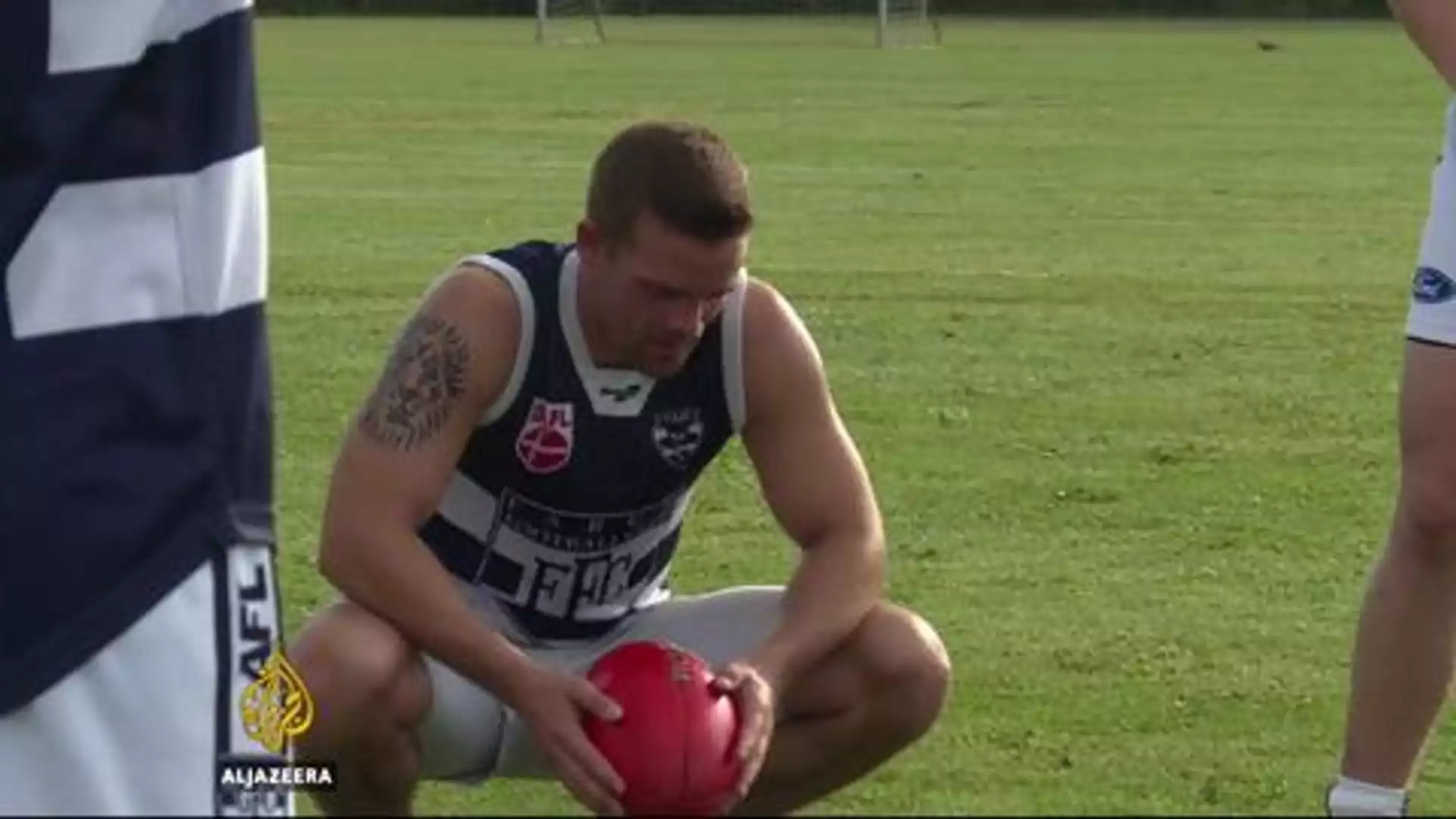Basic rules and positions in Aussie Rules Football
Aussie Rules Football, also known as Australian Football or Footy, is a unique and fast-paced sport played primarily in Australia. Before diving into the fundamental skills, it's essential to familiarize yourself with the basic rules and positions. The game is played on an oval-shaped field with 18 players on each team. The objective is to score goals by kicking the ball between the two tall goalposts.
In Aussie Rules Football, there are several positions, each with its own responsibilities and roles on the field. The positions include full-back, half-back, midfielders, half-forward, full-forward, and ruckman. Each player's position determines their area of play and the skills required to excel in that position. Understanding the positions and their roles will help you better comprehend the game and contribute effectively to your team's success.
Essential skills for playing Aussie Rules Football
To become a proficient Aussie Rules Football player, there are several essential skills you need to master. These skills form the foundation of your game and are crucial for success on the field. The key skills include kicking, handballing, marking, and tackling. Let's take a closer look at each of these skills and how to develop them.
Kicking is one of the most fundamental skills in Aussie Rules Football. It involves striking the ball with your foot to move it towards your teammates or goal. Proper kicking technique is crucial for accuracy and distance. To improve your kicking skills, start by practicing your footwork and balance. Focus on keeping your eye on the ball and striking it with the middle of your foot. Regular practice and repetition will help you develop a consistent and powerful kick.
Improving kicking skills in Aussie Rules Football
To improve your kicking skills in Aussie Rules Football, it's essential to focus on both accuracy and distance. Accuracy is all about hitting your target consistently, whether it's a teammate or the goalposts. Distance, on the other hand, is about kicking the ball as far as possible. Here are some tips to help you improve your kicking skills:
1. Practice regularly: Dedicate time to practice your kicking technique every day. The more you practice, the better you'll become.
2. Focus on footwork: Pay attention to your footwork and body positioning. Position your non-kicking foot alongside the ball and use it as a guide for accuracy and balance.
3. Use both feet: Work on developing your skills with both your dominant and non-dominant foot. This will make you a more versatile player on the field.
4. Visualize your target: Before kicking the ball, visualize your target and focus on hitting it accurately. This mental visualization can greatly improve your accuracy.
5. Seek feedback: Don't be afraid to ask for feedback from coaches or experienced players. They can provide valuable insights and help you identify areas for improvement.
By consistently practicing these tips, you'll see a significant improvement in your kicking skills. Remember, practice makes perfect, so keep at it and strive for continuous improvement.
Mastering handballing techniques in Aussie Rules Football
Handballing, also known as handpassing, is another essential skill in Aussie Rules Football. It involves using your hand to pass the ball to a teammate. Handballing is a quick and effective way to move the ball around the field and create scoring opportunities. To master handballing techniques, follow these steps:
1. Grip the ball: Hold the ball with one hand, placing your fingers along the seam for better control.
2. Use your other hand for support: Place your non-dominant hand on the side of the ball to provide stability and control during the handball.
3. Extend your arm: As you handball, extend your arm fully, using a punching motion to propel the ball towards your teammate.
4. Follow through: After releasing the ball, follow through with your hand, pointing in the direction of your target.
It's important to practice handballing with both hands to develop ambidextrous skills. Focus on accuracy and speed, aiming to deliver the ball to your teammate's chest or in front of them for an easy pick-up. Regular practice and repetition will help you refine your handballing technique and become a more effective player on the field.
Understanding marking and tackling in Aussie Rules Football
Marking and tackling are two crucial skills in Aussie Rules Football, both in offense and defense. Marking involves catching the ball after it has been kicked by an opponent or teammate. Tackling, on the other hand, is the act of stopping an opponent by grabbing or tackling them to the ground. Let's explore these skills in more detail:
Marking requires good timing, judgment, and the ability to read the flight of the ball. When attempting a mark, position yourself in front of your opponent and time your jump to catch the ball at its highest point. Extend your arms fully to increase your reach and create a strong grip on the ball. Practice marking with different types of kicks, such as high kicks and low kicks, to improve your versatility.
Tackling is a defensive skill used to stop opponents from advancing with the ball. It's important to tackle safely and within the rules of the game. Aim to tackle below the shoulders and avoid high contact. When tackling, approach your opponent from the front or side and wrap your arms around them to bring them to the ground. Practice tackling techniques with a partner or during team drills to improve your tackling skills.
Both marking and tackling require physicality, agility, and anticipation. Regular practice and game experience will help you develop these skills and become a more well-rounded player on the field. Remember to always prioritize safety and play within the rules of the game.
Fitness and conditioning for Aussie Rules Football
Aussie Rules Football is a physically demanding sport that requires a high level of fitness and conditioning. To perform at your best and prevent injuries, it's important to focus on your overall fitness. Here are some key areas to consider:
1. Cardiovascular endurance: Build your aerobic fitness through activities like running, cycling, or swimming. This will help you maintain a high level of endurance throughout the game.
2. Strength training: Incorporate strength training exercises to improve your muscular strength and power. Focus on exercises that target the major muscle groups used in Aussie Rules Football, such as squats, lunges, and deadlifts.
3. Agility and speed: Work on drills that improve your agility, speed, and change of direction. This will help you navigate the field quickly and evade opponents.
4. Flexibility and mobility: Stretch regularly to improve your flexibility and mobility. This will enhance your range of motion and reduce the risk of injuries.
5. Recovery and rest: Allow your body enough time to recover between training sessions and games. This will prevent overtraining and promote optimal performance.
Remember to always consult with a professional trainer or coach to design a fitness program that suits your individual needs and goals. Proper nutrition and hydration are also essential for optimal performance and recovery. Fuel your body with nutritious foods and stay hydrated throughout training and games.
Developing game sense and decision-making in Aussie Rules Football
In addition to mastering the physical skills, developing game sense and decision-making abilities is crucial in Aussie Rules Football. Game sense refers to the ability to read the game, anticipate movements, and make effective decisions in real-time. Here are some tips to develop your game sense:
1. Watch and analyze games: Study professional games and observe the movements and decision-making of experienced players. Pay attention to positioning, decision-making under pressure, and team strategies.
2. Play regularly: The more game time you get, the better you'll understand the flow of the game and learn to make quick decisions. Join local leagues or participate in practice matches to gain valuable experience.
3. Communicate with teammates: Effective communication with your teammates is essential for coordinated play. Develop a language of signals and calls to enhance teamwork and decision-making on the field.
4. Visualize scenarios: Spend time visualizing different game scenarios and think about the best decisions you can make in each situation. This mental preparation will help you react quickly and make smart choices during the game.
Developing game sense takes time and experience, so be patient with yourself. As you gain more exposure to the game and apply your skills in different situations, your decision-making abilities will improve.
Training drills and exercises for Aussie Rules Football
To further enhance your skills and fitness, incorporating specific training drills and exercises into your routine is crucial. Here are some drills and exercises that can help you improve your Aussie Rules Football performance:
1. Shuttle runs: Set up markers at different distances and sprint back and forth between them. This drill improves your speed, agility, and endurance.
2. Handball accuracy: Set up targets at various distances and practice handballing the ball into them. Focus on accuracy and speed.
3. Kicking accuracy: Set up targets and practice kicking the ball into them from different angles and distances. Work on both short and long-range kicking.
4. 1-on-1 tackling: Pair up with a teammate and practice tackling each other in a controlled environment. Focus on technique and safety.
5. Game simulations: Set up small-sided games that mimic real-game situations. This will help you apply your skills in a game-like scenario and improve your decision-making abilities.
Incorporate these drills and exercises into your training routine to target specific skills and improve overall performance. Mix up your training sessions to keep them challenging and engaging. Remember to warm up properly before each training session and cool down afterward to prevent injuries.








.png?size=50)

